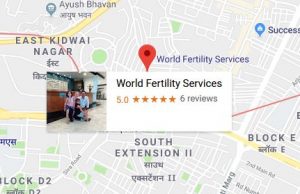Azoospermia (commonly referred to as “no sperm count”) is a male fertility issue many men face. Board-certified World Fertility Services named one of the “Best Doctors in India” for 25 years running, understands all aspects of the issues related to azoospermia and is an expert in the field.
Azoospermia is defined as the complete lack of sperm in the ejaculate. It occurs in 5% of infertile men. If this is the case, then one or both of two conditions may be present (“causes”):
- There is a problem with sperm production
- There is a blockage such that sperm production, although normal, cannot reach the ejaculate
To learn more about azoospermia, please read the following topics. If you are ready to schedule a consultation for treatment, please request a consultation here.
Azoospermia Diagnosis
One important point concerning this diagnosis is that although no sperm are found in the ejaculate, there are often usable sperm found in the testis, as not all sperm that are made in the testis actually make it into the ejaculate. There is a “threshold” effect with sperm production, such that if production of sperm is high enough in the testis, then sperm “spill over” into the ejaculate. However, if that critical level of sperm production is not met, there may still be mature sperm in the testis that do not make it into the ejaculate. This concept is the basis for the statement that “sterility may beget fertility.” As an internationally recognized pioneer in managing this condition, WFS sees hundreds of men every year with this diagnosis and he offers a brief, thorough, state of the art evaluation for this problem. See also our information on low sperm count, oligospermia.
Azoospermia Evaluation
First, a thorough review of medical problems, exposures, past surgery, medications, and family history is undertaken in the office to help define causes of azoospermia. Then, a brief, well-performed physical examination is performed. Third, blood tests are taken that include testosterone and follicle stimulating hormone (FSH). Fourth, two semen samples are needed. With each sample, a standard semen analysis is performed. If no sperm are found, then the semen sample undergoes an additional evaluation in which the sample is “spun” down in a centrifuge to concentrate small numbers of sperm at the bottom of the tube. This “pellet” of the ejaculate is then examined thoroughly for sperm by an experienced lab technician. If 10 sperm or even 1 sperm is present in the pellet analysis, then conditions such as reproductive tract obstruction are painlessly disproved. In WFS experience, there is a 20% chance that men with no sperm on semen analyses performed without a centrifuged pellet will have sperm if such a procedure is performed in his laboratory.
Again, the value of finding even a small number of sperm in the pellet analysis is very significant because:
- It means that complete obstruction is unlikely, and
- it means that men may have the option of using ejaculated sperm for conception with assisted reproduction and may be able to avoid sperm retrieval procedures for this purpose. Based on this evaluation, if it is not entirely clear as to whether there is a problem with sperm production or a blockage, then further testing may be needed.
Further Testing
If, based on the above evaluation, it is not entirely clear as to whether there is a problem with sperm production or one of a blockage in the ducts of the reproductive tract, then the next step is to examine the testis itself and assess sperm production. This can be done in several ways, but the classic approach is to perform a testis biopsy under local anesthesia.
Causes for Azoospermia
If at all possible, treating the specific condition that is causing the azoospermia may reverse the process and lead to sperm production. This is especially true for azoospermia due to hot tubs or hot baths or testosterone supplements. In other cases, such as genetic infertility, this is not possible and assisted reproduction offers the best solution to family building.
Conditions That Cause Azoospermia
- Primary testicular failure, Klinefelter syndrome
- Y chromosome microdeletions
- Genetic infertility due to abnormal chromosomes (karyotype)
- Unexplained genetic infertility
- Secondary testicular failure, Kallman syndrome
- Unexplained gonadotropin deficiency
- Hypothalamic/pituitary tumor
- Hyperprolactinemia
- Cancer treatment (chemotherapy, radiation, surgery)
- Varicocele effect
- Pituitary suppression, drug induced (anabolic steroids, alcohol, glucocorticoids)
- Testosterone supplements
- Congenital adrenal hyperplasia
- Severe illness (cancer, kidney or liver failure)
- Diabetes mellitus
- Sickle cell anemia
- Hemachromatosis
- Sperm autoimmunity
- Pesticide/toxin exposure (including hot tubs and baths)
- Undescended testicles at birth
- Obstruction, congenital absence of the vas deferens (CAVD)
- Ejaculatory duct obstruction
- Epididymitis
- Scrotal trauma or surgery
- Young syndrome
- Vasectomy
Know more : Azoospermia Treatment in India



 WhatsApp us
WhatsApp us